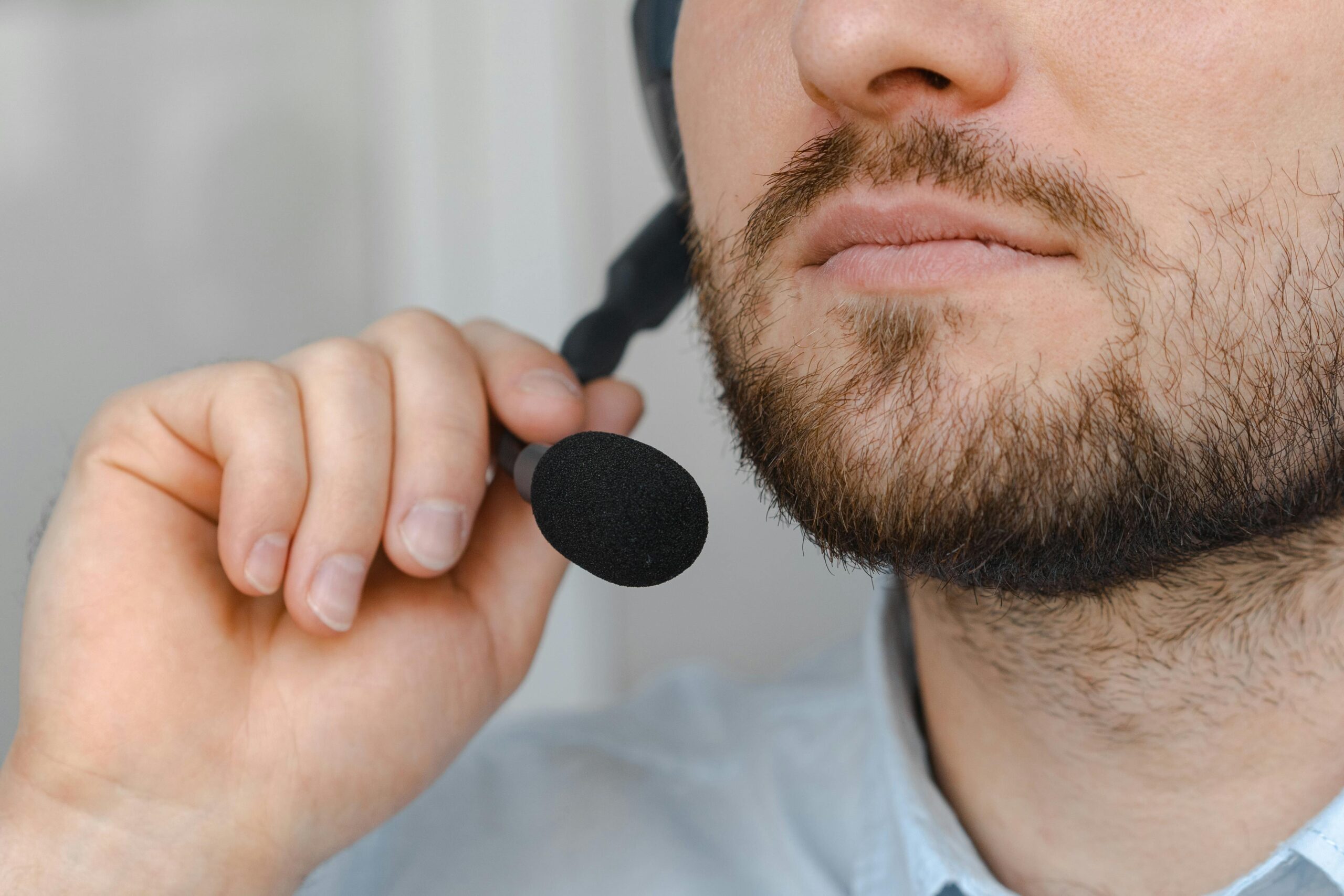Many people struggle with voice issues, such as losing their voice during a presentation or feeling hoarse after a day of talking. Vocal warm-ups for speaking can help solve these problems by making the voice strong and clear. As experienced vocal coaches, we’re offering our top techniques for keeping the voice in top form while speaking in public.
Vocal Warm-Ups for Speaking
Consistent vocal exercises are vital for those who speak for extended periods. They prepare the vocal cords to maintain clarity and prevent vocal fatigue.
 Warm-up exercises also increase blood flow to the muscles involved in speech. This preparation reduces the risk of strain and damage, which is particularly vital for professionals like teachers, broadcasters, and public speakers.
Warm-up exercises also increase blood flow to the muscles involved in speech. This preparation reduces the risk of strain and damage, which is particularly vital for professionals like teachers, broadcasters, and public speakers.
In addition, vocal warm-ups enhance performance and support long-term vocal health. Structured vocal training exercises can protect against common issues like hoarseness and vocal nodules.
Benefits of Vocal Warm-Ups
One in five Americans are reported to have a voice disorder. Vocal warm-ups help maintain and improve vocal health and prevent vocal cord issues.
Vocal warm-ups help the vocal cords, which comprise small muscles, warm up and become more flexible. This is important because, like any muscle, vocal cords need to be prepared before intense use to avoid strain and injury. Warming up the voice provides multiple advantages. Some include:
- Strengthening the vocal muscles to allow for better control over pitch, tone, and volume. Particularly beneficial during presentations where articulation is key.
- Improving respiratory efficiency. Controlled breathing techniques enable speakers to manage their breath more effectively, reducing the need for gasping for air mid-sentence.
- Enhancing resonance and clarity. Specific exercises, such as humming or lip trills, help in achieving a more vibrant voice, leading to engaging and persuasive communication.
Situations Where Warm-Ups Are Necessary
Vocal warm-ups are important in various contexts. Public speaking events like conferences and seminars demand clear and powerful speech. Warming up helps speakers maintain vocal quality throughout their presentations.
In performing arts, vocal exercises are mandatory for actors and singers to deliver consistent performances. Preparing beforehand ensures their voices maintain the tone and quality through rehearsals without strain.
Professionals in customer service roles also benefit from vocal warm-ups. Speaking with customers for prolonged periods requires a clear, pleasant voice. Exercises can help maintain this even during busy periods. Educators, too, can find vocal warm-ups invaluable. Teaching requires extended speaking, and vocal preparation supports daily performance.
Physiology of the Voice
The human voice depends on a complex system of anatomical structures, and warm-ups can significantly affect vocal health. Knowing how these structures work can help get the maximum benefits of vocal exercises.
The Basic Anatomy
The voice is produced by the coordinated effort of the lungs, vocal folds, and articulators. The lungs provide airflow, which passes through the trachea. The vocal folds in the larynx vibrate to create sound waves. Sound is then shaped by the mouth, tongue, and lips. This group of structures is known as the articulators.
The diaphragm, a large muscle below the lungs, plays a vital role. It controls breathing and provides the support needed for sustained vocalization. Proper airflow regulation and tension in the vocal folds are important to prevent strain.
The resonance of the voice depends on the chest, throat, and nasal cavities. These areas amplify and enrich the sound, making it fuller and more vibrant. Variations in this system result in different vocal qualities and pitches.
How Warm-Ups Impact Vocal Health
Warm-ups prepare the voice by increasing blood flow and flexibility in the vocal folds. This process reduces the risk of injury and enhances performance. Simple exercises like humming or lip trills can gradually build up vocal strength.
Stretching and relaxation are key components. Loosening the muscles around the larynx and diaphragm increases the range of motion, making it easier to hit higher or lower notes and speak with clarity. Hydration is also important, as it keeps the vocal folds lubricated, reducing friction and wear.
Sustained practice of warm-ups supports long-term vocal health. They help in maintaining stamina and flexibility, making it easier to handle prolonged speaking activities or performances.
Breathing Exercises
Effective vocal warm-up starts with breathing exercises, which enhance lung capacity and promote relaxation. These exercises are vital for clear speech.
Let’s look at some basic breathing techniques.
Diaphragmatic Breathing Techniques
Diaphragmatic breathing, also known as abdominal breathing, engages the diaphragm rather than the chest. To practice this:
- Sit or lie down comfortably.
- Place one hand on the chest and the other on the abdomen.
- Inhale deeply through the nose, ensuring the abdomen rises more than the chest.
- Exhale slowly through pursed lips, focusing on the movement of the diaphragm.
- Repeat this cycle for a few minutes, maintaining a steady rhythm.
Controlled diaphragmatic breathing can improve vocal strength and stamina, providing a stable foundation for speaking.
Breathing Drills for Relaxation
Certain breathing drills help reduce tension and anxiety, which can hinder vocal performance. One effective drill is the 4-7-8 technique. To do this:
- Sit comfortably with a straight back.
- Inhale quietly through the nose for a count of four.
- Hold your breath for a count of seven.
- Exhale completely through the mouth for a count of eight.
Complete this cycle three to four times, focusing on the breath and maintaining a calm state of mind. This drill helps to center the speaker, promoting a relaxed and confident delivery.
Vocal Stretching Exercises
These exercises focus on stretching and relaxing key areas, such as the neck, shoulders, jaw, and tongue, to prepare the voice for speaking.
Neck and Shoulder Stretches
Stretching the neck and shoulders helps release tension that can affect vocal performance. To perform a neck and shoulder stretch, follow these steps:
- Slowly bend the neck to the left, bringing the ear towards the shoulder.
- Hold for 10-15 seconds, then repeat on the right side.
- Next, roll the shoulders in a circular motion: Five times forward, then five times backward to loosen the shoulder girdle.
- Include an upper back stretch by interlocking the fingers, pushing the palms away from the chest, and rounding the upper back.
- Hold for a few seconds to elongate the spine and relax the upper body muscles.
 Jaw and Tongue Exercises
Jaw and Tongue Exercises
Proper jaw and tongue flexibility is vital for clear speech. To do it:
- Gently rub the jaw muscles in a circular motion to increase blood flow.
- Next, open the mouth wide, then slowly close it. Repeat this movement 5-10 times to improve jaw mobility.
- Stick the tongue out as far as possible, then move it side to side.
Holding each position for a few seconds can enhance flexibility.
Resonance Exercises
Improving vocal resonance can significantly enhance speaking clarity and presence. Let’s discuss the key methods: Humming and lip trills, and resonance placement techniques.
Humming and Lip Trills
Humming is a simple yet effective way to warm up the voice. It helps in feeling vibrations in the lips, face, and chest. Begin by taking a deep breath and humming at a comfortable pitch, focusing on the facial vibrations. This technique not only prepares the vocal cords yet also enhances resonance and control.
Lip trills, commonly known as “lip bubbles”, are another excellent exercise. They involve vibrating the lips while exhaling. It’s vital to maintain steady airflow and avoid straining. These exercises help improve breath support, relaxation, and vocal cord connection.
Resonance Placement Techniques
Resonance placement techniques involve focusing the sound in different areas of the face and body to enhance vocal quality. Start by placing fingers on the nose and speaking or humming, focusing on sending vibrations to the nose. This helps find the “mask” resonance, enhancing vocal brightness.
Another method is the “chest voice” exercise. Place a hand on the chest and speak in a low, resonant voice, feeling the vibrations. Practicing these techniques daily can help diversify vocal tones and assure a fuller, richer sound.
| Routine | Benefit |
| Breathing exercises | Relaxation, breath control |
| Lip trills | Loosens lips |
| Tongue twisters | Articulation, speed |
| Humming | Warms vocal cords |
| Jaw relaxation | Eases jaw tension |
| Neck/shoulder stretches | Relieves tension |
These exercises are easy to incorporate into a daily schedule and can significantly benefit your vocal performance.
 Related Questions
Related Questions
How Long Should a Vocal Warm-up Session Be?
A typical vocal warm-up session for speaking should last about 10 to 20 minutes. Shorter sessions may not fully prepare the vocal cords, while longer sessions could lead to unnecessary strain. Specific exercises might include humming, lip trills, and tongue twisters, each performed for a few minutes.
Can Vocal Warm-Ups Help Reduce Speaking Anxiety?
Yes, vocal warm-ups can help reduce speaking anxiety by increasing confidence and familiarity with one’s voice. Exercises such as deep breathing and gentle humming can calm the mind and prepare the body for speaking.
Are Vocal Warm-Ups Necessary for Non-professional Speakers?
For those who speak frequently in social or work settings, warm-ups can help maintain vocal integrity and prevent damage. Simple exercises can enhance projection and enunciation, making regular communication more effective.
Conclusion
Practicing vocal warm-ups in daily routines can significantly enhance speaking abilities. Simple exercises such as lip trills, tongue twisters, and deep breathing relieve tension and improve clarity. Regular practice ensures better breath control, increased vocal range, and stronger projection. This results in improved confidence and performance in teleprompter speaking, presentations, public speaking, and everyday conversations.






